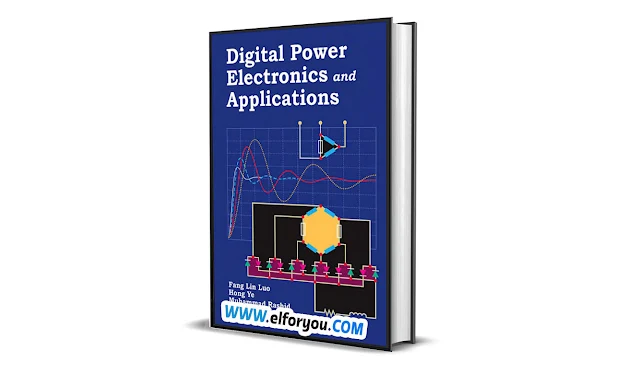Digital Power Electronics and Applications PDF.
About:
A revolution occurs in the paradigm within the power electronics area, replacing traditional ways of thought with a modern view of the control theory. Taking this approach, the authors begin their revolutionary quest in Numerical Control Theory for Power Electronics.
Often unnoticed, such as the air is for breathing, power electronics provide an instrumental means of transporting electrical energy from the source to the consumer. This critical domain is as essential as drinking water and breathing air in an uninterrupted process of energy transfer. Yet, there is a book that disputes the idea of conforming exclusively to the conventional analog control approach which was established for more than one hundred years.
The book, “Digital Power Electronics and Application”, is based on a solid theoretical foundation, describing various possible applications of them. The study which comprises about 400 pages is laid out carefully with close to 300 graphs to ensure comprehension. Using modern digital technology as power electronics control has been proven effective in this article, and it can overcome misconceptions like analog control in the right way.
Traditionally, power electronics have been analyzed through the lens of analog control theory, producing commendable results. However, these successes have inadvertently led to the misguided belief that analog control is the ultimate and final solution for Power Electronics. The authors challenge this misconception, emphasizing that mature control methods should not mark the end but rather the beginning of a new chapter for Power Electronics.
A fundamental aspect of this exploration is the meticulous examination of power transmission technology. AC and DC drive systems, acting as the conduits between electrical and mechanical energy, come under the scrutiny of the authors. These systems, collectively known as power supplies, operate through switching circuits that function in discrete states of on and off. The high-frequency semiconductor devices within these circuits enable the realization of high power rates, efficiency, cost-effectiveness, compact size, and elevated energy density.
An intriguing revelation emerges as the authors draw attention to the vast difference in size between a flat transformer operating at 250 kHz and a conventional transformer at 50 Hz, both handling the same power rate. The intermittent operation of switching circuits, operating periodically in states of on and off, challenges the traditional notion of constant energy flow. Instead, these circuits, along with transformers, facilitate power transfer by quantizing energy across specific storage elements, loading it in predefined sampling periods.
In essence, "Digital Power Electronics and Applications" redefines the landscape of Power Electronics. It invites readers to question conventional wisdom, encouraging a shift towards digital control methods. By dispelling the notion of a sunset in the knowledge of Power Electronics, the authors breathe new life into this critical field, ushering it into a future where the digital frontier reigns supreme.
Contents ِchapter:
1. Introduction:
A wide introductory section will be used as a basis for understanding the role played by power electronics and the use of digital control systems. It is in this section that the role of digital technologies as a catalyst in power-related applications will be explored.
2. Energy Factor (EF) and Sub-sequential Parameters:
This section highlights the Energy Factor (EF) as well as its main parameters. It gives detailed insights into the drivers of energy efficiency. Y
3. Basic Mathematics of Digital Control Systems:
This section lays the foundation by explaining the basic mathematical knowledge of digital control systems. First, it presents essential initial mathematics on which one depends when understanding the complexities involved with digital signal processing in power electronics.
4. Mathematical Modeling of Digital Power Electronics:
This section looks at the theoretical foundations of the mathematical modeling of digital power electronics. It describes the theories and methods used in developing models representing the conduct of a digital system.
5. Digitally Controlled AC/DC Rectifiers:
This section looks into the use of digital control on AC/DC rectifiers and how it improves performance. This focuses on the enhanced benefits of digital control in this power electronics application. #
6. Digitally Controlled DC/AC Inverters:
The second part is about digital control of inversion specifically on DC/AC inverter. This paper examines how digital technologies affect the conversion of power from a DC source and it focuses on economy and accuracy.
7. Digitally Controlled DC/DC Converters:
This section delves into the processes involved in DC/DC conversion and traverses the terrain of digitally controlled DC/DC converters. The digital control theory explains the use of voltage conversion and regulation in power systems.
8. Open-loop Control for Digital Power Electronics:
Unveiling the principles of open-loop control, this section examines its practical application in digital power electronics. It elucidates how open-loop verification systems operate without feedback, providing a comprehensive sympathy for this control methodology.
9. Closed-Loop Control for Digital Power Electronics:
Building on the concepts of closed-loop control, this section explores its practical application in whole number power electronics. It delves into the advantages of feedback mechanisms, accenting precision and stability in controlling world power systems.
10. Energy Factor Application in AC and DC Motor Drives:
This section explores the practical application of the vitality Factor (EF) in alternating current and DC motor drives. It investigates how energy-undefined considerations regulate the design and operation of motor drive systems under whole number control.
11. Applications in Other Branches of Power Electronics:
Concluding the exploration, this segment broadens the scope to various applications in other branches of major power electronics. It highlights diverse scenarios where digital control systems bring invention and efficiency to power-related technologies.
Information:
Title: Digital Power Electronics and Applications.
Language: English.
Size: 4.65 Mb.
Pages: 421.
Format: PDF.
Author: By Fang Lin Luo,Hong Ye and Muhammad Rashid.
